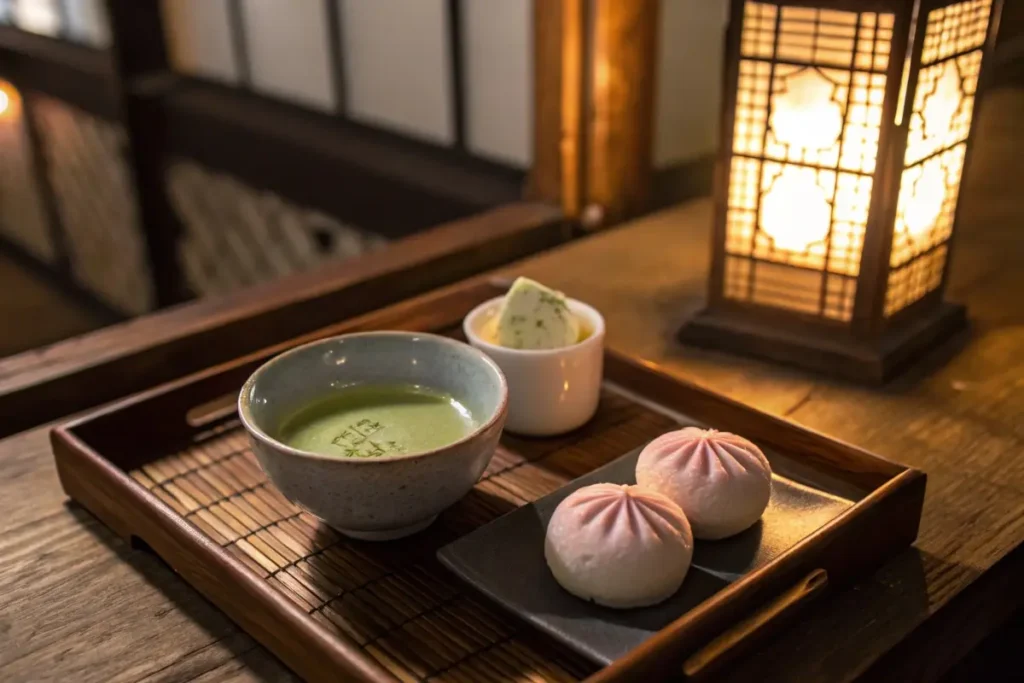Indulging in a japanese tea dessert offers a window into the intricate relationship between tea culture and sweet confections in Japan. From wagashi (traditional Japanese sweets) to contemporary fusion treats, these desserts often feature subtle sweetness and delicate flavors—perfectly complementing the bitterness or umami of various teas. What Japanese dessert is served with tea? The answer spans everything from classic wagashi to creative patisserie items. In this comprehensive guide, we’ll explore what are Japanese tea sweets called, what is the famous dessert in Japan, and what are the Japanese sweets for tea ceremonies. Along the way, we’ll uncover centuries-old rituals, modern innovations, and practical tips for pairing and enjoying these confections.
If you’re curious about broader Japanese dessert culture beyond tea, explore our Japanese Dessert Recipes for ideas that range from mochi-based sweets to sweet potato–infused confections. Now, let’s dive in and discover how tea and dessert entwine in Japan’s gastronomic tapestry.
Introduction
For centuries, tea has been a cornerstone of Japanese hospitality and culture. The ritual of serving tea—particularly matcha—is intimately connected with an array of confections collectively known as wagashi, each meticulously designed to harmonize with the tea’s flavor. Hence, japanese tea dessert goes beyond mere sugary indulgence; it’s an art form that encapsulates seasonality, regional produce, and aesthetic grace. What are Japanese tea sweets called? You’ll encounter terms like wagashi and namagashi in formal tea ceremonies, while casual gatherings might feature simpler sweets such as dorayaki or manju.
In recent times, new dessert trends—from matcha tiramisu to green tea roll cakes—have expanded the possibilities. These fusions maintain the core principle of balancing sweetness against the tea’s sometimes astringent or bitter notes. What is the famous dessert in Japan? Classics like daifuku, taiyaki, and anko-filled pastries still reign, but modern patisseries continue to innovate. Whether you’re interested in the spiritual calm of a tea ceremony or simply craving a sweet treat to enjoy with your afternoon brew, Japan’s tea-inspired desserts promise a unique sensory experience.
To see how traditional Japanese sweets can evolve with new twists, check out our Traditional Japanese Desserts Recipe. You’ll find a variety of confections that either pair seamlessly with tea or stand alone as a satisfying treat. Let’s embark on a journey through the world of Japanese tea desserts—from the refined world of the chanoyu ceremony to the playful realm of snack-inspired sweets.
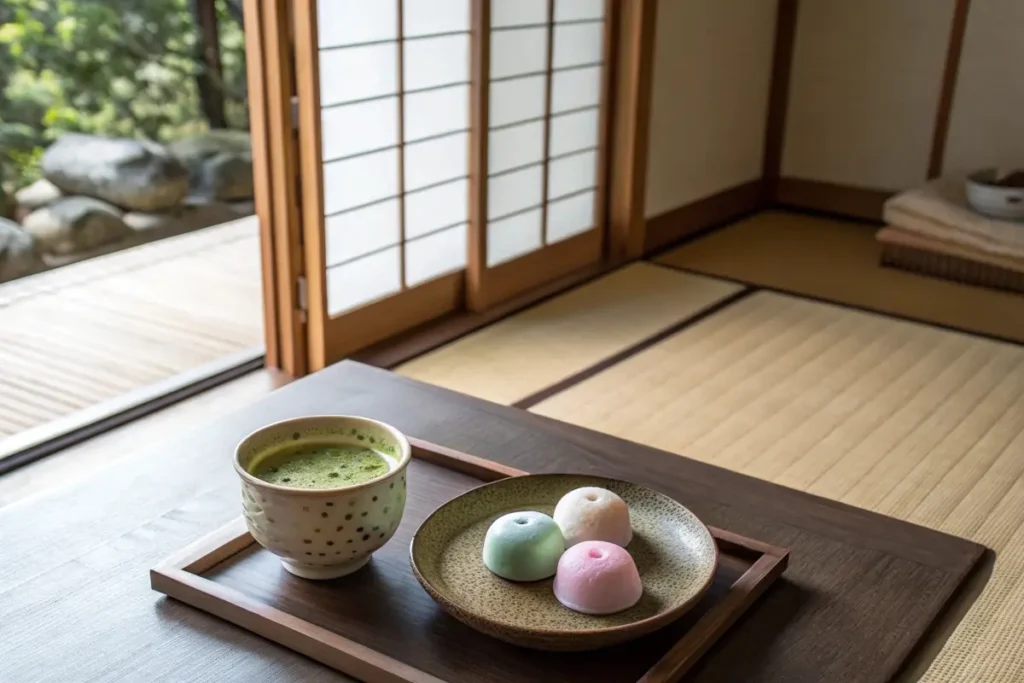
The Essence of Japanese Tea Desserts
1. Defining Wagashi and Its Role
Wagashi literally means “Japanese sweets,” encompassing confections crafted primarily from plant-based ingredients—like rice flour, sweet bean paste (anko), and agar (kanten). Historically, these delicacies were developed specifically to complement tea’s flavor profile. In particular, matcha—which can be somewhat bitter—balances beautifully against sweet, delicate tastes.
- Seasonality Matters: Many wagashi reflect the current season, featuring motifs like cherry blossoms in spring or maple leaves in autumn.
- Textural Diversity: Ranging from chewy mochi to jelly-like yokan, each sweet offers an interplay of consistency and subtle sweetness.
2. Harmony with Tea
In Japan, chanoyu (the tea ceremony) underlines aesthetics, respect, and mindfulness. The japanese tea dessert is selected to mirror the ephemeral beauty of nature or the ceremony’s occasion. A tiny portion suffices, highlighting how sweetness is best savored in moderation:
- Balancing Bitterness: Matcha’s earthy bitterness needs a mild sweetness to cleanse the palate. Overly sugary desserts can overwhelm.
- Quality Over Quantity: Each piece of wagashi is a petite work of art, focusing on presentation as well as taste.
3. Modern Confections
While classic wagashi hold cultural weight, modern desserts merge Western pastry techniques with local ingredients like green tea or sweet bean paste. Examples include matcha roll cakes, matcha crepes, and even green tea cheesecakes. Despite Western influences, these items remain faithful to the principle of moderation, ensuring the tea’s aroma stays center stage.
4. Types of Tea and Dessert Pairings
- Matcha: Typically served with namagashi (fresh sweets), which have a soft, moist texture. Namagashi might feature bean paste molded into seasonal shapes.
- Sencha: A more astringent, grassy tea that pairs well with simpler confections—like dorayaki or even a lightly sweet biscuit.
- Hojicha: Its roasted notes go nicely with creamy or milky desserts, including matcha tiramisu or a subtle custard infused with tea leaves.
- Genmaicha: The toasted rice in this tea complements nutty flavors in sweets, such as sesame or peanut-based treats.
5. Where to Find Japanese Tea Desserts
In Japan, sweet shops near temples or scenic gardens often specialize in wagashi. Urban cafes also incorporate matcha-laced pastries, bridging old and new. Internationally, Japanese patisseries or specialized tea houses might carry a selection of these sweets, reflecting global appetite for matcha’s distinctive taste.
For a deeper look at Japanese sweets beyond tea pairing, consider our Japanese Cookies for everyday treats with a Japanese twist. The adaptability of wagashi—and Japan’s tea culture—ensures an evolving dessert landscape that values aesthetic grace, balanced flavors, and mindful consumption.
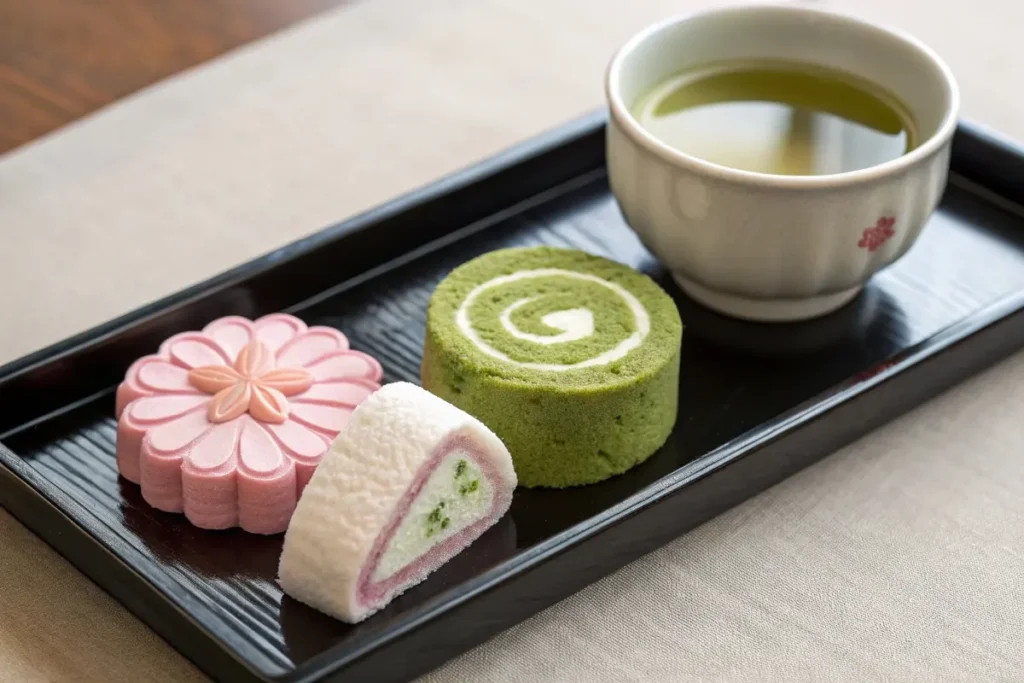
Components and Techniques of Japanese Tea Sweets
1. Key Ingredients
- Anko (Sweet Bean Paste): The foundation for many wagashi. Azuki beans, boiled and sweetened, yield a smooth or coarse paste. Vital for mochi fillings, dorayaki, and manju.
- Mochiko/Rice Flour: Creates the chewy mochi texture. Blended with water and sometimes sugar, it forms the dough for confections like daifuku or ichigo daifuku.
- Kanten (Agar): A seaweed-based gelling agent, offering a firmer texture than gelatin. Used in jellies like yokan or mizu yokan, popular in summer.
- Matcha Powder: Adds earthy bitterness, vibrant color, and a wealth of antioxidants. Perfect for roll cakes, creme brulee, or even wagashi glazes.
2. Traditional Preparation Methods
Steaming and Kneading: Many tea sweets, particularly namagashi, call for gentle steaming of rice flour or bean paste. The craftsman then hand-kneads the mixture into intricate shapes, from blossoms to leaves. This method fosters an elegant mouthfeel and locks in moisture.
Shaping and Molding: Artisans often use wooden or silicone molds to create decorative patterns. For mochi-based sweets, the dough is stretched and pinched around fillings—like red bean paste—before carefully sealed.
3. Western Influence and Hybrids
Matcha Chocolate Confections: Some shops swirl matcha and white chocolate for a fudgy treat with visual marbling. Ideal for those seeking a sweet punch of cocoa balanced by tea’s slight bitterness.
Tea-Infused Pastries: From chiffon cakes to shortbread cookies, matcha or hoji-cha (roasted green tea) can be integrated into flours, batters, or frostings. The outcome merges fluffiness or crispness with a subtle tea aroma.
Layered Desserts: Japanese sweet potato dessert or chestnut creams may also get layered with tea-based sponges, bridging multiple flavor profiles. The synergy of earthy sweet potato, chestnut, and matcha yields a sophisticated dessert that gracefully pairs with any tea type.
4. Balancing Sweetness and Bitterness
Subtle Sugars: Japanese desserts typically use less sugar than Western pastries, maintaining a delicate equilibrium. This principle ensures each bite accentuates the tea’s nuances rather than overshadowing them.
Syrups and Dustings: For example, kinako (toasted soybean flour) or black honey (kuromitsu) are optional garnishes, letting individuals modulate sweetness. This flexible approach resonates with the tea ceremony’s concept of gentle personalization.
5. Perfect Texture Techniques
- Glutinous Rice Mastery: Overcooking mochi can lead to a gummy mouthfeel, while undercooking leaves lumps. Finding the sweet spot yields soft, pliable dough.
- Anko Consistency: The paste should be moist yet firm enough to hold shape. Overly wet anko bleeds flavor into the dough; too dry results in crumbly texture.
Looking for a simpler path? Our Japanese Chicken Fried Rice Recipe obviously isn’t sweet, but you’ll see the same emphasis on balancing taste. The same principle of “not overshadowing key flavors” stands in Japanese desserts as well.
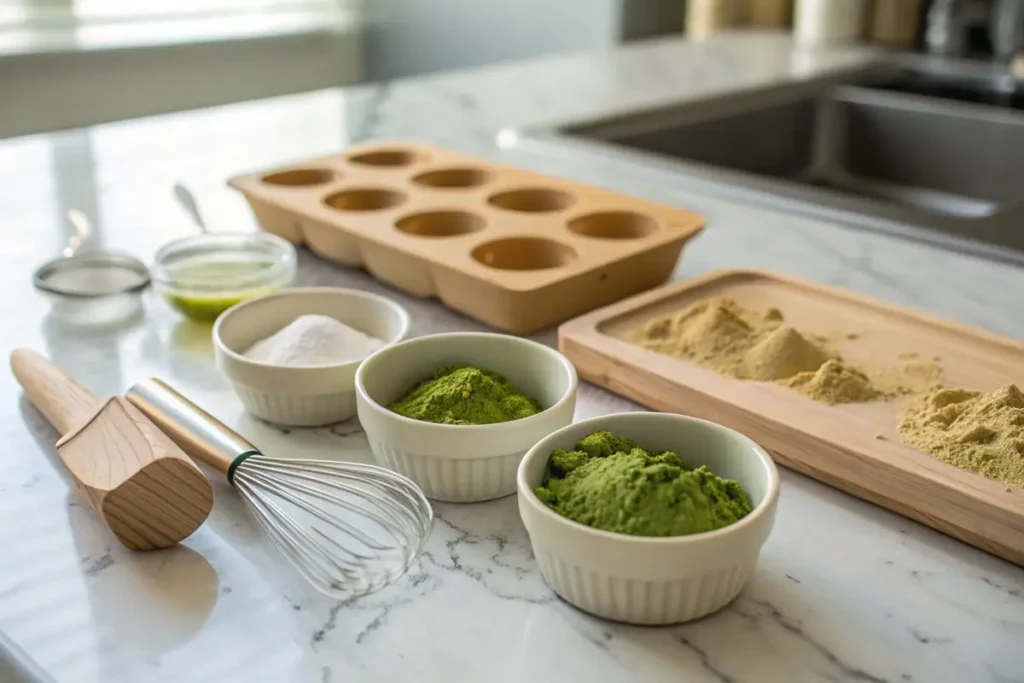
History and Examples: Japanese Tea Dessert
1. Historical Ties to Tea Ceremonies
Tea ceremonies (chanoyu) date back to the 16th century, formalized by masters like Sen no Rikyū. Along with the procedure for whisking matcha, a quiet highlight has always been the small sweet served beforehand. Wagashi in those days were simpler—perhaps a spherical mochi or a wedge of jelly (yokan). Over centuries, local artisans refined these sweets, tailoring them to each season or festival.
- Edo Period Innovations (1603–1868): Urban tea houses and sweet shops proliferated, capitalizing on popular demand for elegantly designed confections. The era’s creativity birthed iconic shapes and color usage, eventually influencing modern dessert presentations.
2. Notable Past Masters and Regions
Different Japanese regions have distinct tea dessert specialties. For instance, Kyoto is synonymous with yatsuhashi (cinnamon-flavored mochi sheets) and delicate namagashi served in ryokan. Tokyo, as a cultural melting pot, introduced more modern spins—like dorayaki pancakes or taiyaki fish-shaped pastries. Notable wagashi masters remain, passing down artisanal secrets across generations.
3. Classic Examples of Tea Desserts
- Monaka: Crisp wafer shells filled with anko or chestnut paste. Often served with a green tea to offset the wafer’s dryness.
- Mizu Yokan: A cool, jelly-like block of sweet bean and agar—perfect for hot summers.
- Daifuku: Soft mochi stuffed with sweet bean paste, some variations adding whipped cream or strawberries (ichigo daifuku).
4. Modern Resurgence
While consumption of wagashi dipped slightly amid Western pastry’s surge, a renewed interest in tea ceremonies and cultural heritage is reviving the popularity of these sweets. The recent wave of Instagrammable desserts sees matcha lattes crowned with whipped foam or dango skewers dusted with gold leaf. Experimental shops also produce bright pastel mochi dumplings or incorporate fruit-based fillings for a fresh twist.
- Global Appeal: Many international tea salons or Japanese-themed cafes around the world now serve matcha tiramisu or mochi doughnuts, bridging centuries of tradition with global dessert trends.
- Healthy Positioning: As wagashi often use plant-based ingredients, they align well with health-conscious consumers seeking moderate sweetness. For instance, adzuki beans deliver protein and fiber, while mochi is typically gluten-free.
For a hands-on exploration, see our Traditional Japanese Desserts Recipe to discover easy entries into wagashi-making, each step reflecting centuries of refinement. The evolutionary path from humble tea sweets to contemporary innovations reveals how resilience and creativity fuel these confections’ enduring charm.
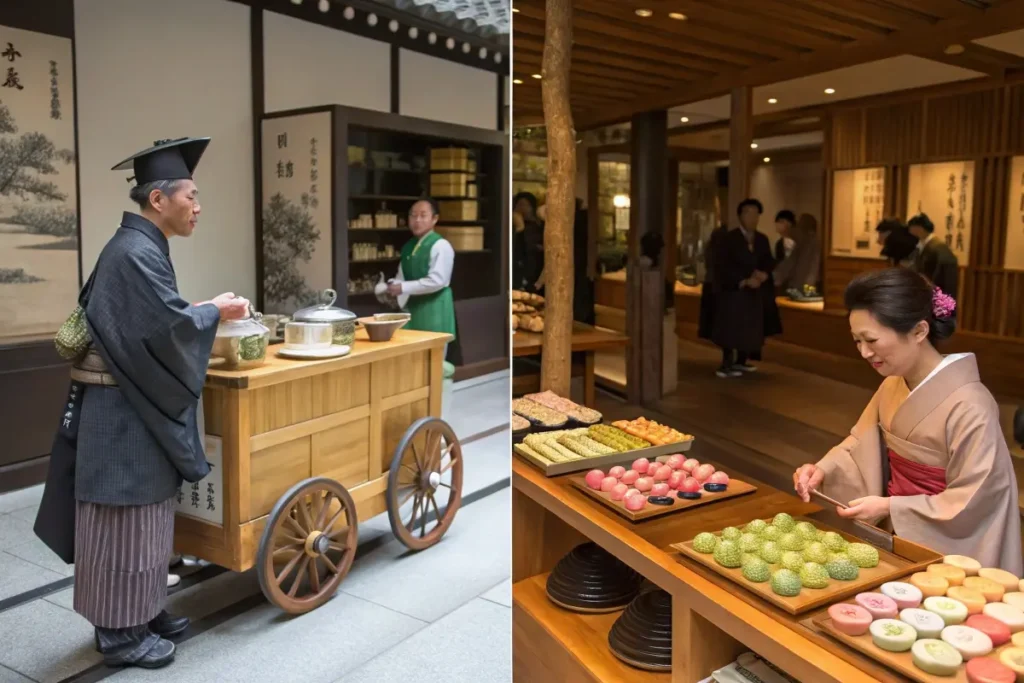
Practical Examples/Use Cases
1. Hosting a Casual Tea Gathering
Scenario: You invite a few friends over for a relaxed afternoon tea, wanting to add a Japanese flair.
- Approach: Offer matcha or sencha, accompanied by bite-sized mochi and dorayaki (small pancake sandwiches with bean paste). A lighter sweet, like mizu yokan, offers a refreshing choice.
- Benefit: Guests savor new textures and flavors, discovering how a modest dessert portion can harmonize elegantly with tea.
2. Restaurant Dessert Menus
Scenario: A fusion restaurant aims to broaden its dessert list.
- Approach: Incorporate a matcha creme brulee or a matcha tiramisu, plus an option for traditional warabi mochi drizzled in kuromitsu (black honey).
- Result: Diners relish a cross-cultural dessert journey, appealing to local tea enthusiasts and adventurous sweet tooths.
3. Cafe Special Promotions
Scenario: A cafe focuses on seasonal promotions.
- Approach: During spring, they highlight sakura-flavored mochi or pastel-hued tea cakes. In autumn, a kabocha (pumpkin) mochi with black sesame seeds.
- Reason: Seasonal desserts align with Japan’s nature-centric mindset, delighting patrons who crave novelty each season.
4. Educational Workshops
Scenario: A cultural center offers wagashi-making workshops to those curious about what are Japanese tea sweets called.
- Approach: In a short session, participants learn to shape basic nerikiri (pressed dough sweets). They also get tips on pairing them with different teas.
- Outcome: Attendees appreciate the artistry behind each sweet, bridging tradition and personal enjoyment.
5. International Gifting
Scenario: You want a unique present for a friend living abroad.
- Approach: Send a packaged box of carefully chosen tea desserts—like freeze-dried mochi or daifuku that can travel well.
- Advantage: Introduces them to a slice of Japan’s refined sweetness, perhaps encouraging them to replicate a mini tea session at home.
For more dessert inspiration—beyond solely tea—see our Japanese Biscuits Recipe for snackable treats that can pair equally well with coffee or tea. These everyday bites also fit the Japanese sweet ethos: moderate sugar, high emphasis on textural satisfaction, and a hint of creative flair.
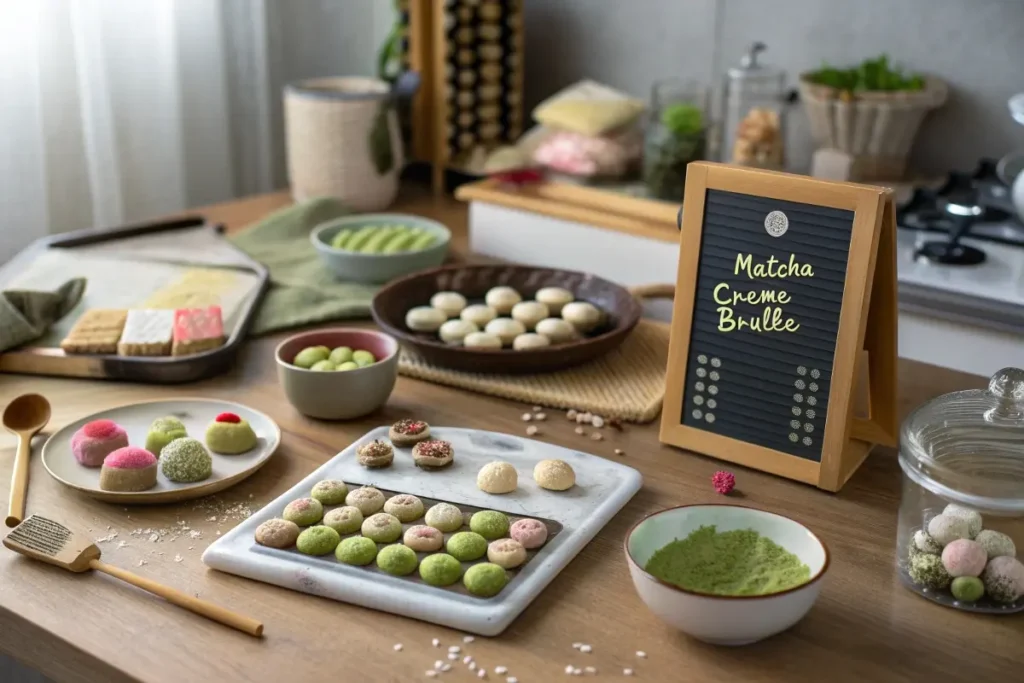
FAQs
1. What Japanese dessert is served with tea?
Many confections, collectively known as wagashi, pair with tea. Common examples include mochi, manju, and yokan. These sweets often feature mild sweetness from red bean paste (anko) or sweet potato, balanced to complement the earthy or bitter notes of teas like matcha or sencha.
2. What are Japanese tea sweets called?
They’re broadly called wagashi, a term covering diverse shapes and textures such as daifuku (mochi stuffed with bean paste), dorayaki (pancake sandwich), or namagashi (fresh, handcrafted seasonal sweets). Wagashi usually rely on plant-based ingredients—rice flour, bean paste, sugar, agar—and reflect aesthetic harmony.
3. What is the famous dessert in Japan?
While “famous dessert” can vary by region, mochi and its variants—like matcha daifuku—are highly recognized internationally. Wagashi also includes taiyaki, a fish-shaped pastry, and the ubiquitous anpan (sweet bean bun). Not to mention, castella sponge cake has historical acclaim. For tea, specifically, wagashi stands out.
4. What are the Japanese sweets for tea ceremonies?
Tea ceremonies revolve around delicate, handcrafted sweets called chagashi or namagashi. These could be subtle bean paste shapes referencing the current season—like a lotus bloom for summer or a maple leaf in autumn. The gentle sweetness harmonizes with the slight bitterness of matcha.
5. How sweet are Japanese tea desserts?
Japanese tea sweets lean toward moderate sweetness. They enhance the tea’s flavor without overwhelming it. While modern creations may feature more sugar or Western influences, traditional wagashi maintain a delicate balance, ensuring the taste of tea remains central.
6. Can I replicate them at home?
Yes. Many recipes—like mochi or yokan—use readily accessible ingredients: glutinous rice flour, sweet bean paste, sugar, agar. Detailed tutorials can help novices shape sweets. For advanced tasks like intricate nerikiri, practice is key. Explore our Japanese Vegan Recipes for plant-based, simpler takes on tea-friendly sweets.
7. Are these desserts only for matcha?
Not at all. While matcha is iconic, sencha, genmaicha, hojicha, and other teas each pair well with different sweets. Some pastries might complement roasted tea’s smoky notes, while fruit-based confections might lighten up a more robust tea.
Conclusion
Japanese tea dessert is more than just a sweet treat; it’s a cultural expression of harmony, respect for ingredients, and seasonal sensitivity. Whether indulging in a classic wagashi like daifuku or venturing into modern matcha-infused pastries, each piece strikes a delicate balance that accentuates tea’s nuanced flavors. The result? A moment of calm reflection, reminiscent of the tea ceremony’s essence, where dessert and beverage entwine in a mindful experience.
Intrigued by the subtle complexities of these confections? Start by sourcing basic ingredients—matcha powder, sweet bean paste, or mochi flour—and explore simple recipes like mochi or yokan. For deeper exploration, consider visiting a specialized wagashi shop or participating in a workshop. As you savor each bite, remember that these desserts symbolize centuries of craft, shaped by Japan’s reverence for nature and aesthetic detail.
If you’re excited to add a Japanese tea dessert to your repertoire, check out our Japanese Cookies for a lighter treat that can pair well with everything from matcha to hojicha. Ultimately, the world of Japanese tea desserts welcomes any sweet enthusiast craving understated elegance and gastronomic harmony—no prior ceremony skills required.
